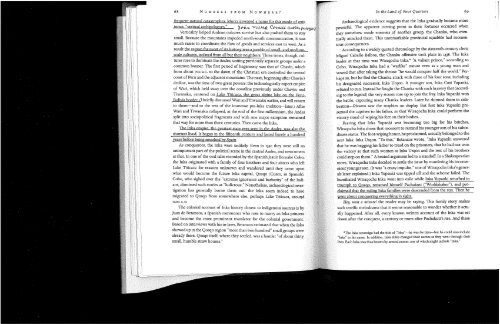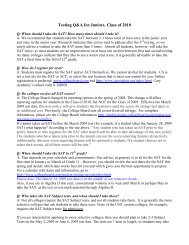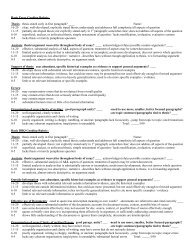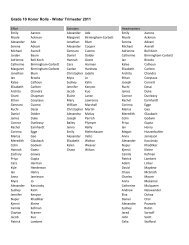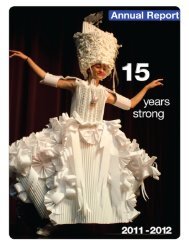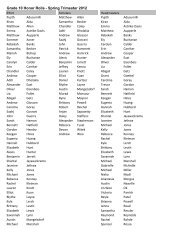CHARLES C. MANN - Cary Academy
CHARLES C. MANN - Cary Academy
CHARLES C. MANN - Cary Academy
- No tags were found...
Create successful ePaper yourself
Turn your PDF publications into a flip-book with our unique Google optimized e-Paper software.
68 NUMBERS FROM NOWHERE?frequent natural catastrophes. Murra invented a name for this mode of existence:"vertical archipelagoes." '&~ -n-UW«t ('''''''>UU 0,d:ft,lo. F'de/m-ilVerticality helped Andean cultures survive but also pushed them to staysmall. Because the mountains impeded north-south communication, it wasmuch easier to coordinate the flow of goods and services east to west. As aresult the..r.egiou for most Of jts history was a jllwbJe of smaJl~ and medjJ]m~scale cultures, isolated from all but their neighbors. Three times, though, culturesrose to dominate the Andes, uniting previously separate groups under acommon banner. The first period of hegemony was that of Chavin, whichfrom about 700 B.C. to the dawn of the Christian era controlled the centralcoast of Peru and the adjacent mountains. The next, beginning afrer Chavin'sdecline, was the time of two great powers: the technologically expert empireof Wari, which held sway over the coastline previously under Chavin; andTiwanaku, centered on Lake Titicaca. the great alPine lake ou the PeruBolivia border. !I briefly discussed Wari and Tiwanaku earlier, and will returnto them-and to the rest of the immense pre-Inka tradition-later.) AlierWari and Tiwanaku collapsed, at the end of the first millennium, the Andessplit into sociopolitical fragments and with one major exception remainedthat way for more than three centuries. Then came the Inka.The Ipka empire the greatest state ever seen in the Andes was also theshortest lived. It began in the fifteenth century and lasted barely a hundredyears before being smashed by Spain.As conquerors, the Inka were unlikely. Even in 1350 they were still anunimportant part of the political scene in the central Andes, and newcomersat that. In one of the oral tales recorded by the Spanish Jesuit Bernabe Cobo,the Inka originated with a family of four brothers and four sisters who leftLake Titicaca for reasons unknown and wandered until they came uponwhat would become the future Inka capital, Qosqo (Cusco, in Spanish).Cobo, who sighed over the "extreme ignorance and barbarity" of the Indians,dismissed such stories as "ludicrous." Nonetheless, archaeological investigationhas generally borne them out: the Inka seem indeed to havemigrated to Qosqo from somewhere else, perhaps Lake Titicaca, around1200 A.D.The colonial account of Inka history closest to indigenous sources is byJuan de Betanzos, a Spanish commoner who rose to marry an Inka princessand become the most prominent translator for the colonial government.Based on interviews with his in-laws, Betanzos estimated that when the Inkashowed up in the Qosqo region "more than two hundred" small groups werealready there. Qosqo itself, where they settled, was a hamlet "of about thirtysmall, humble straw houses."In the Land of Four QuartersArchaeological evidence suggests that the Inka gradually became morepowerful. The apparent turning point in their fortunes occurred whenthey somehow made enemies of another group, the Chanka, who eventuallyattacked them. This unremarkable provincial squabble had momentOUSconsequences.According to a widely quoted chronology by the Sixteenth-century clericMiguel Cabello Balboa, the Chanka offensive took place in 1438. The Inkaleader at that time was Wiraqocba Inka. * "A valiant prince," according toCobo, Wiraqocha Inka had a "warlike" nature even as a young man andvowed that after taking the throne "he would conquer half the world." Per- .haps so, but he fled the Chanka attack with three of his four sons, includinghis designated successor, Inka Urqon. A younger son, Inka Cusi Yupanki,refused to run. Instead he fought the Chanka with such bravery that (accordingto the legend) the very stones rose up to join the fray. Inka Yupanki wonthe battle, capturing many Chanka leaders. Later he skinned them in celebration-Pizarrosaw the trophies on display. But first Inka Yupanki presentedthe captives to his father, so that Wiraqocha Inka could perform thevictory ritual of wiping his feet on their bodies.Fearing that Inka Yupanki was becoming too big for his britches,Wiraqocha Inka chose that moment to remind his younger son of his subordinatestatus. The foot-wiping honor, he proclaimed, actually belonged to thenext Inka: Inka Urqon. "To this," Betanzos wrote, "Inka Yupanki answeredthat he was begging his father to ttead on the prisoners, that he had not wonthe victory so that such women as Inka Urqon and the rest of his brotherscould step on them." A heated argument led to a standoff. In a Shakespearianmove, Wiraqocha Inka decided to settle the issue by murdering his inconvenientyoungerson. (It was "a crazy impulse," one of Wiraqocha Inkas generalslater explained.) Inka Yupanki was tipped off and the scheme failed. Thehumillated Wiraqocha Inka went into exile while Inka Yupanki returned intriumph to 00s90, renamed himself Pachakuti ("Worldshaker"), and pro,claimed that the ruling Inka families were descended from the sun, Then hewent about conquering everything in sight,Hey, wait a minute! the reader may be saying, This family story makessuch terrific melodrama that it seems reasonable to wonder whether it actuallyhappened. After all, every known written account of the Inka was setdown after the conquest, a century or more after Pachakut;'s rise. And these*The Inka sovereign had the tide of "Inka"-he was the Inka-but he could also include"Inka" in his name. In addition, Inka elites changed their names as they went through theirlives. Each Inka was thus known by several names, any of which might include "Inka."


